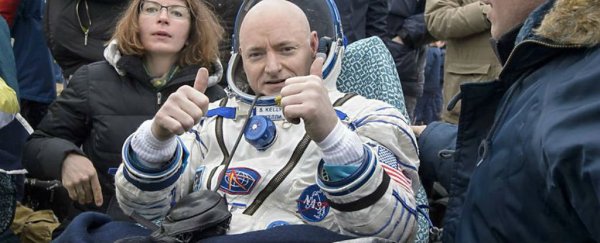If humanity is ever going to realise its ambitions of travelling to Mars and elsewhere in the Solar System, one of the challenges we're going to have to address is how to stay healthy in space over long periods of time. NASA estimates it's going to take at least 150 days for humans to get to Mars, and that's a long time to be exposed to things like cosmic radiation without the benefits of Earth's protective magnetic field.
Unfortunately, some of the latest research on the effects of spending time in space doesn't have very positive findings. A recent study found that mice flown aboard the space shuttle Atlantis returned to Earth with the early signs of liver disease – and the animals were only off the planet for less than a fortnight.
After 13.5 days onboard the shuttle during its final flight in 2011, the mice were studied by a team of scientists including anaesthesiologist and physicist Karen Jonscher from the University of Colorado. The team found that even a short duration of spaceflight appeared to activate specialised liver cells that can induce scarring and cause long-term liver damage.
"Prior to this study we really didn't have much information on the impact of spaceflight on the liver," said Jonscher. "We knew that astronauts often returned with diabetes-like symptoms, but they usually resolved quickly."
Unlike other studies that have analysed the effects of cosmic radiation on mouse brains to see how exposure to space could impact the animals' cognitive abilities, the researchers don't think radiation is what caused the liver damage in this case.
The more likely culprit is the relative lack of gravity in a microgravity environment, which scientists think has a negative influence on the animals' metabolisms.
"We saw the beginning of nascent liver damage in just 13.5 days," said Jonscher. "The mice also lost lean muscle mass. We have seen this same phenomenon in humans on bedrest – muscles atrophy and proteins break down into amino acids. The question is, how does that affect your liver?"
When the space-faring mice were compared with a control group that stayed on Earth, samples taken from the travellers indicated increased fat storage in their livers, along with lower levels of retinol – an animal form of Vitamin A – and changes to the levels of genes that help break down fats.
Taken together, these are all signs of non-alcoholic fatty liver disease (NAFLD), and potential early indicators of fibrosis. The most disturbing aspect of the findings, which are reported in PLOS ONE, is the rapid timeframe in which these symptoms developed in the animals.
"It generally takes a long time, months to years, to induce fibrosis in mice, even when eating an unhealthy diet," said Jonscher. "If a mouse is showing nascent signs of fibrosis without a change in diet after 13.5 days, what is happening to the humans?"
While NASA is aware of some of the risks that altered gravity fields can have on the human body – listing it first on a rundown of factors that could impact our health in space – liver damage isn't one of the risks reported, indicating we may still have a lot to learn in this area.
Of course, one of the primary scientific goals of NASA astronaut Scott Kelly's famous 'year in space' was the unique opportunity to see what such a long-haul trip off the planet did to the human body – with Kelly's twin brother, former astronaut Mark Kelly, serving as an Earth-based control.
The most remarkable and immediate (and temporary) effect seen was Scott Kelly growing an astonishing 5 centimetres (2 inches) taller over the course of the year, due to the reduced gravity environment onboard the International Space Station – but NASA's ongoing research into the pair and their health will be long-lasting.
In the meantime, scientists will need to do a lot more research to gauge the potential of liver damage from space travel, both in mice and humans. And aside from any technological measures we can implement to try to reduce or mitigate the health risks of space, the researchers also acknowledge the situation might not be quite as stark as these early results suggest.
"Whether or not this is a problem is an open question," said Jonscher. "We need to look at mice involved in longer duration space flight to see if there are compensatory mechanisms that come into play that might protect them from serious damage."
